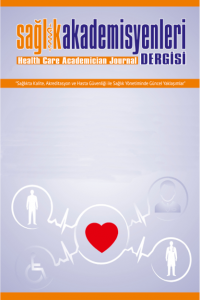COVİD-19 PANDEMİ SÜRECİNDE LİSE SON SINIF ÖĞRENCİLERİNİN PSİKOSOSYAL VE REHBERLİK GEREKSİNİMLERİ BELİRLENMESİ
covid-19, lise son sınıf öğrencileri, , psikososyal gereksinimler, rehberlik
Determınatıon Of Psychosocıal And Guıdance Requırements Of Hıgh School Senıors Durıng The Covıd-19 Pandemıc Process
HİGH SCHOOL STUDENT, COVID-19, PANDEMİ, DETERMINATİON,
___
- 1. Chen, Y., Liu, Q., &Guo, D. (2020). Emerging coronaviruses: genomestructure, replication, and pathogenesis. Journal of medical virology, 92(4), 418-423.
- 2. Rothan, H. A., & Byrareddy, S. N. (2020). The epidemiology and pathogenesis of coronavirus disease (COVID-19) outbreak. Journal of autoimmunity, 102433.
- 3. Jiao, W. Y., Wang, L. N., Liu, J., Fang, S. F., Jiao, F. Y., Pettoello-Mantovani, M., &Somekh, E. (2020). Behavioral and emotional disorders in children during the COVID-19 epidemic. Thejournal of Pediatrics, 221, 264.
- 4. World Health Organization. Director-General’sremarks at theme diabriefing on 2019-nCoV on 11 February 2020. https:// www.who.int/dg/speeches/detail/who-director-generals-remarks-at-the-media-briefing-on-2019-ncov-on-11february-2020 (Accessed on Jully 23, 2020).
- 5. T.C. Sağlık Bakanlığı. https://covid19asi.saglik.gov.tr/TR-77706/covid-19-asisi-ulusal-uygulama-stratejisi.html (Erişim Tarihi: 12.07.2020).
- 6. Wang, C., Cheng, Z., Yue, X.G., &McAleer, M. (2020). Risk Management of Covid-19 byUniversities in China. Journal of Risk and Financial Management,13: 36-42.
- 7. Orru, G., Ciacchini, R., Gemignani, A., & Conversano, C.(2020). Psychological intervention measures during the COVID-19 pandemic. Clinical Neuropsychiatry, 17(2), 76-79. 8. Brooks, S. K., Webster, R. K., Smith, L. E., Woodland, L., Wessely, S., Greenberg, N., &Rubin, G. J. (2020). The psychological impact of quarantine and how to reduce it: rapid review of the evidence. TheLancet. doi:https://doi.org/10.1016/S0140-6736(20)30460-8.
- 9. Qiu, J., Shen, B., Zhao, M., Wang, Z., Xie, B., &Xu, Y. (2020). A nationwidesurvey of psychological distress among Chinese people in the COVİD 19 epidemic: implications and policy recommendations. General Psychiatry, 33(2). https://dx.doi.org/10.1136%2Fgpsych-2020-100213.
- 10. Sarı, H. İ. (2020). Evde kal döneminde uzaktan eğitim: Ölçme ve değerlendirmeyi neden karantinaya almamalıyız? Uluslararası Eğitim Araştırmacıları Dergisi, 3(1), 121-128.
- 11. Çakın, M., Külekçi Akyavuz, E. (2020). The Covid-19 process and its reflection on education: An analysis on teachers’ opinions. International Journal of Social Sciences and Education Research, 6(2), 165-186.
- 12. Ekici, G. (2005). Lise öğrencilerinin öğrenci seçme sınavına (ÖSS) yönelik tutumlarının bazı değişkenler açısından incelenmesi. Hacettepe Üniversitesi Eğitim Fakültesi Dergisi, 28(28), 82-90.
- 13. Yıldırım, A., & Şimşek, H. (2016). Qualitativeresearchmethods in socialsciences, 10th ed. Seçkin Publishing.
- 14. Güler, A., Halıcıoğlu, M.B. ve Taşğın, S. (2013). Sosyal bilimlerde nitel araştırma yöntemleri. Ankara: Seçkin Yayıncılık.
- 15. Büyüköztürk, Ş., Çakmak Kılıç, E., Akgün, Ö. E., Karadeniz, Ş., Demirel, F. (2018). Bilimsel araştırma yöntemleri. Ankara: Pegem Akademi Yayıncılık.
- 16. Colaizzi, P. (1978). Psychologicalresearch as thephenomenologist’sview it. In R. Vale & M. King (Eds.), Existential–phenomenologicalalternativesforpsychology (pp. 48–71). New York: Oxford University Pres.
- 17. Morrow, R., Rodriguez, A., &King, N. (2015). Colaizzi’s descriptive phenomenological method. ThePsychologist, 28(8), 643–644.
- 18. Tong, A., Sainsbury, P., &Craig, J. (2007). Consolidated criteria for reporting qualitative research (COREQ): A 32-item checklist for interviews and focus groups. International Journal for Quality in Health Care, 19(6), 349–357. https://doi.org/10.1093/intqh c/mzm042.
- 19. Kara, Y.(2020). Pandemi Sürecindeki Öğrenci Deneyimleri: Bakırköy İlçesi Örneği. Avrasya Sosyal ve Ekonomi Araştırmaları Dergisi, 7(7), 165-176.
- 20. Bozkurt, A. Koronavirüs (Covid-19) Pandemisi Sırasında İlköğretim Öğrencilerinin Uzaktan Eğitime Yönelik İmge ve Algıları: Bir Metafor Analizi. Uşak Üniversitesi Eğitim Araştırmaları Dergisi, 6(2), 1-23.
- 21. Short, J., Williams, E., &Christie, B. (1976). The social psychology of tele communications.London: Wiley.
- 22. Wiener, M., &Mehrabian, A. (1968). Language within language: Immediacy, a channel inverbal communication. New York, NY: Appleton-Century-Crofts.
- 23. Argyle, M., & Dean, J. (1965). Eye contact and distance affiliation. Sociometry, 28, 289–304.https://doi.org/10.2307/2786027.
- 24. Hatun, O., Dicle, A. N., & Demirci, İ. Koronavirüs Salgınının Psikolojik Yansımaları ve Salgınla Başa Çıkma. Turkish Studies, 15, 4.
- 25. Coyne, J. C., &DeLongis, A. (1986). Goingbeyondsocialsupport: The role of social relationships in adaptation. Journal of Consulting and Clinical Psychology, 54(4), 454–460. https://doi.org/10.1037/0022-006X.54.4.454.
- 26. House, J. S., Landis, K. R., &Umberson, D. (1988). Social relation ships and health. Science, 241(4865), 540-545. https://doi.org/10.1126/science.3399889.
- 27. Cao, W., Fang, Z., Hou, G., Han, M., Xu, X., Dong, J., &Zheng, J. (2020). The psychological impact of the COVID-19 epidemic on college students in China. PsychiatryResearch, 112934. https://doi.org/10.1016/j.psychres.2020.112934.
- ISSN: 2148-7472
- Yayın Aralığı: Yılda 4 Sayı
- Başlangıç: 2014
- Yayıncı: Dünya Kongre
İnmeli Hastalara Bakım Verenlerde Bakım Yükü, Anksiyete ve Depresyon Düzeyinin İncelenmesi
Doğuma Hazırlık sınıflarında verilen eğitimin doğum memnuniyeti üzerine etkisi
Melike DİŞSİZ, Naciye GELEBEK, Şenay DEMİRBAŞ MEYDAN, Rojjin MAMUK, Dilek BİLGİÇ
Bilge ÖNAL DÖLEK, Ajala Dare ADELEKE
HEMŞİRELERİN ZAMAN YÖNETİMİ KONUSUNDAKİ BAŞARI DÜZEYLERİNİN DEĞERLENDİRİLMESİ
Pelvik organ prolapsusu hakkında en çok alıntı yapılan 100 makale: Bibliyometrik analiz
Ayhan ATIGAN, Alev ATIGAN, Soner GÖK
Hekimlerin Klinik Kaliteye Bakış Açısını Ölçmeye Yönelik Bir Ölçek Geliştirme: Metodolojik Çalışma
Mehmet KOCA, Feyza İNCEOĞLU, Alev KÖKSAL, Serdar DENİZ
Hemşirelik Eğitimine Değişen ve Gelişen Teknolojilerin Yansımaları
Duygu Ceren GÜNGÖR, Fatma ORGUN, Nilay ÖZKÜTÜK
Hemşirelikte Tamamlayıcı Ve Destekleyici Tedaviler Konulu Yayınlara Global Bakış
Hatice ÖNTÜRK AKYÜZ, Selma DİLMEN KALI
Sağlık Turizmi İşletmelerinde Dijital Pazarlama Uygulamalarının Analizi: Kuşadası Örneği
Banu ŞİMŞEK, Ahu YAZICI AYYILDIZ
Covid 19 pandemisinin hemşirelerin psikolojik sağlamlık anksiyete ve depresyon düzeylerine etkisi
